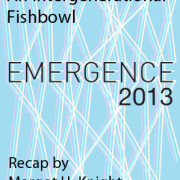An Intergenerational Fishbowl
By Margot H. Knight
A fishbowl marked the finish of Emergence 2013, Emerging Arts Professional’s daylong annual convening on June 4.
Keeping the Talkative Fish Swimming
Even though they can discriminate against the shy, I like fishbowls. I like fishbowls because they provide a focal point for condensing experiences and thoughts. Fishbowls are round and provide a welcome break from the we-talk-you-listen square or oblong formats that stubbornly cling to the most innovative of conferences.
Fishbowls focus on the learner. As teacher and then as learner again, I particularly liked the Emergence 2013 fishbowl because as moderator (the key to any successful fishbowl), Adam Fong did a great job of keeping the talkative fish swimming.
So what did we learn? Here are my takeaways.
Struggling for Cultural Equity
The struggle for cultural equity ’twas ever thus whether the issue is art creation, arts audiences, arts organizations, or arts advocacy. All of which rolls back around to the roles privilege, power, and money play in the cultural sector. By the same token we are, each in our own way, blind to our own advantages in the world.
We would all do well to take our own inventories and be as self-aware as our selfish, self-involved selves can muster.
More important, each generation’s progress towards a more just and inclusive society stands on the risk-taking shoulders of its predecessor generation. Each generation has to find its own language, its own attitude and its own solutions.
Each generation creates new barometers to assess progress, along with its own versions of what Hewlett Foundation program officer Ron Ragin called “the uncomfortable conversation.”
The cultural sector must also contribute to the definition of diversity, cultural equity, and cultural pluralism because sometimes, as Frances Phillips of Arts & Creative Work Fund/Walter and Elise Haas Fund noted in the opening panel, funders can screw things up by defining them.
Uncommon learning with Margot Knight (center) by Kegan Marling
What if We All Worked Together?
I felt a lot of “versus” undertones (we vs. they, big vs. small, new vs. old, old vs. young) and not enough if-we-all-work-together strategies. It sometimes felt like a convention of overwhelmed, put-upon people.
Without whitewashing the economic climate for those new to the job market and emerging arts professionals specifically, the challenge is to find ways to stay in the field and not abandon it for greener for-profit pastures. I heard loud and clear that it’s not just about money when choosing a job—it’s about passion and principles.
But the lack of a clear path to jobs with a desirable salary was a dilemma expressed over and over again in public and private conversations.
Who’s at the Table?
Obstacles to more Bay Area collaboration within the sector are inherent in a field that encompasses varying disciplines, organizational structures, and umbrella organizations. It’s unclear who has the power and who uses it to convene the cultural community at large. It’s unclear who has the trust to represent the cultural community at economic development, policy and planning tables.
Where should that kind of leadership come from? Only the designated heads of big budget organizations? Or can it come from the ranks of groups like Emerging Arts Professionals?
If we don’t take the arts seriously and ask others to do so, whose fault is it that the arts are considered a frill? If we are not serious about our work, we might be unconsciously training other people how to treat us.
An Invitation to Keep Listening
For me, the conference’s promise of a day of uncommon learning was realized. I walked away buoyantly awash in the dedication of conference attendees to take on some pretty big personal, industry, and societal issues.
The tension between the “longing for love and struggle for the legal tender,” as Jackson Browne sings, did nothing to diminish the passion and belief that the arts and artists matter.
All we need to do is keep on listening, talking and taking action. The leadership of Emerging Arts Professionals is providing an open invitation to do that.
Margot H. Knight is executive director of Djerassi Resident Artists Program.





